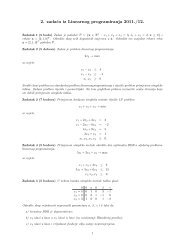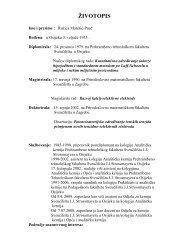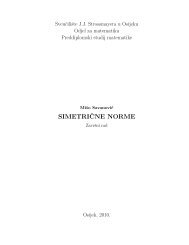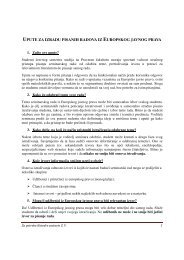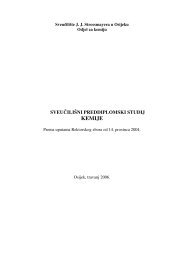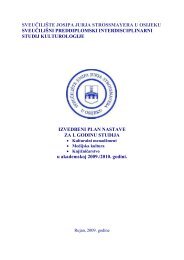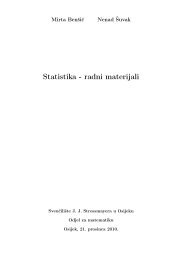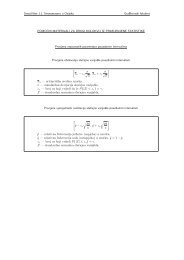Theta lifts of strongly positive discrete series: the case of (˜ Sp(n),O(V ))
Theta lifts of strongly positive discrete series: the case of (˜ Sp(n),O(V ))
Theta lifts of strongly positive discrete series: the case of (˜ Sp(n),O(V ))
You also want an ePaper? Increase the reach of your titles
YUMPU automatically turns print PDFs into web optimized ePapers that Google loves.
j−1mr−n+Especially, a quotient J j0 equals χ V,ψ ν 2 ⊗ ω n−j,r and a subrepresentationJ jj equals IndfM j ×O(V r)GL(j,F <strong>˜</strong> )×P j × <strong>˜</strong>5 Some technical results on <strong>lifts</strong><strong>Sp</strong>(n−j) (χ V,ψ ⊗ Σ ′ j ⊗ ω n−j,r−j ).The purpose <strong>of</strong> this section is to state and prove many technical results whichwill be <strong>of</strong> particular importance in <strong>the</strong> following sections.An elementary but useful criterion for pushing down <strong>the</strong> <strong>lifts</strong> <strong>of</strong> irreduciblerepresentations is established by <strong>the</strong> following two propositions.Proposition 5.1. Let τ ∈ S 1 (r) be an irreducible representation. Then <strong>the</strong>following hold:1. Suppose that Θ(τ, n) ≠ 0. Then R fP 1(Θ(τ, n + 1))(χ V,ψ ν mr−(n+1) ) ≠ 0.2. Suppose that R P1 (τ)(ν mr−(n+1) ) = 0. Then Θ(τ, n) ≠ 0 if and only ifR fP 1(Θ(τ, n + 1))(χ V,ψ ν mr−(n+1) ) ≠ 0.Pro<strong>of</strong>. The pro<strong>of</strong> follows <strong>the</strong> same lines as that <strong>of</strong> Theorem 4.5 <strong>of</strong> [6].Assume that Θ(τ, n) ≠ 0. Then <strong>the</strong>re exists an epimorphism ω n,r →τ ⊗ Θ(τ, n). Kudla’s filtration gives <strong>the</strong> epimorphismsR fP 1(ω n+1,r ) → χ V,ψ ν mr−(n+1) ⊗ ω n,r → χ V,ψ ν mr−(n+1) ⊗ τ ⊗ Θ(τ, n).Using Frobenius reciprocity we get a non-trivial intertwining Θ(τ, n + 1) →χ V,ψ ν mr−(n+1) ⋊ Θ(τ, n). This obviously proves <strong>the</strong> first statement <strong>of</strong> <strong>the</strong>proposition.It remains to prove sufficiency in <strong>the</strong> second statement. The conditionR fP 1(Θ(τ, n + 1))(χ V,ψ ν mr−(n+1) ) ≠ 0 gives Θ(τ, n + 1) ≠ 0, that gives anepimorphism ω n+1,r → τ ⊗ Θ(τ, n + 1). Applying Jacquet modules, we getan epimorphism R fP 1(ω n+1,r ) → τ ⊗ χ V,ψ ν mr−(n+1) ⊗ σ ′ for some irreduciblerepresentation σ ′ ∈ S 1 (n). If we suppose that <strong>the</strong> restriction <strong>of</strong> this epimorphismto a subrepresentation J 11 is non-zero, second Frobenius reciprocitygives a non-zero intertwining mapχ V,ψ ⊗ Σ ′ 1 ⊗ ω n,r−1 → <strong>˜</strong>R P1 (<strong>˜</strong>τ) ⊗ χ V,ψ ν mr−(n+1) ⊗ σ ′ .From this intertwining we deduce τ ↩→ ν mr−(n+1) ⋊ τ ′ , for some irreduciblerepresentation τ ′ ∈ S 2 (r − 1), contradicting <strong>the</strong> assumption <strong>of</strong> proposition.Consequently, <strong>the</strong>re exists a non-zero intertwining J 10 → τ ⊗χ V,ψ ν mr−(n+1) ⊗σ ′ , which gives Θ(τ, n) ≠ 0.16



